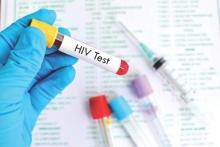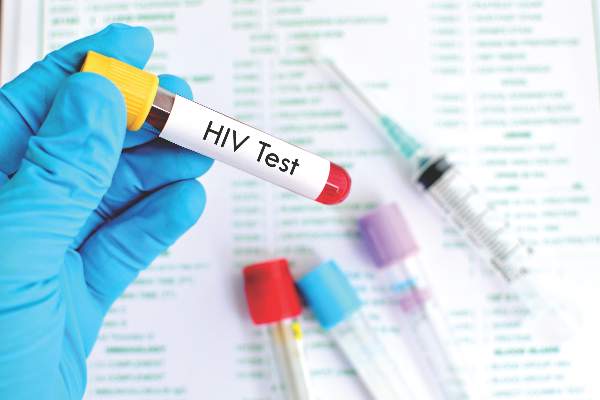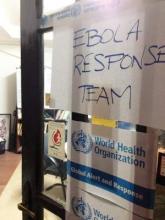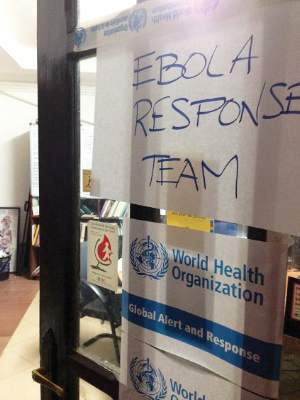User login
Richard Pizzi is editor of The Hospitalist. He has been an editor at Frontline Medical Communications since 2015, and previously served as editor of MDedge publications Hospitalist News and ID Practitioner. He has also worked as an editor and in editorial management roles for HIMSS Media, MedTech Media, and the American Association for Clinical Chemistry. Follow him on Twitter @richpizzi
HIV rapid tests miss 1 in 7 infections
Rapid HIV tests in high-income countries miss about one in seven infections and should be used in combination with fourth-generation enzyme immunoassays (EIA) or nucleic acid amplification tests (NAAT) in clinical settings, according to a study in the journal AIDS.
“These infections are likely to be particularly transmissible due to the high HIV viral load in early infection ... in high-income countries, rapid tests should be used in combination with fourth-generation EIA or NAAT, except in special circumstances,” the Australian researchers said.
They performed a systematic review and meta-analysis of 18 studies involving 110,122 HIV rapid test results. The primary outcome was the test’s sensitivity for detecting acute or established HIV infections. Sensitivity was calculated by dividing the number of confirmed positive rapid tests by the number of confirmed positive comparator tests. Specificity was calculated by dividing the number of confirmed negative rapid tests by the number of negative comparator tests.
Compared with EIA, the estimated sensitivity of rapid tests was 94.5% (95% confidence interval, 87.4-97.7). Compared with NAAT, the sensitivity of rapid tests was 93.7% (95% CI, 88.7-96.5). The sensitivity of rapid tests in high income countries was 85.7% (95% CI, 81.9-88.9), and in low income countries was 97.7% (95% CI, 95.2-98·9), compared with either EIA or NAAT (P less than .01 for difference between settings). Proportions of antibody negative acute infections were 13.6% (95% CI, 10.1-18.0) and 4.7% (95% CI, 2.8-7.7) in studies from high- and low-income countries respectively (P less than .01).
Rapid tests were less sensitive when used in clinical settings in high-income countries, regardless of whether they were compared with a NAAT or fourth-generation EIA. However, the researchers noted that the discrepancy between high- and low-income countries could be attributed to the higher proportion of acute HIV infections (antibody-negative NAAT positive) in populations tested in high-income countries, which might reflect higher background testing rates or a higher incidence of HIV in men who have sex with men.
Read the full study in AIDS (doi: 10.1097/QAD.0000000000001134).
On Twitter @richpizzi
Rapid HIV tests in high-income countries miss about one in seven infections and should be used in combination with fourth-generation enzyme immunoassays (EIA) or nucleic acid amplification tests (NAAT) in clinical settings, according to a study in the journal AIDS.
“These infections are likely to be particularly transmissible due to the high HIV viral load in early infection ... in high-income countries, rapid tests should be used in combination with fourth-generation EIA or NAAT, except in special circumstances,” the Australian researchers said.
They performed a systematic review and meta-analysis of 18 studies involving 110,122 HIV rapid test results. The primary outcome was the test’s sensitivity for detecting acute or established HIV infections. Sensitivity was calculated by dividing the number of confirmed positive rapid tests by the number of confirmed positive comparator tests. Specificity was calculated by dividing the number of confirmed negative rapid tests by the number of negative comparator tests.
Compared with EIA, the estimated sensitivity of rapid tests was 94.5% (95% confidence interval, 87.4-97.7). Compared with NAAT, the sensitivity of rapid tests was 93.7% (95% CI, 88.7-96.5). The sensitivity of rapid tests in high income countries was 85.7% (95% CI, 81.9-88.9), and in low income countries was 97.7% (95% CI, 95.2-98·9), compared with either EIA or NAAT (P less than .01 for difference between settings). Proportions of antibody negative acute infections were 13.6% (95% CI, 10.1-18.0) and 4.7% (95% CI, 2.8-7.7) in studies from high- and low-income countries respectively (P less than .01).
Rapid tests were less sensitive when used in clinical settings in high-income countries, regardless of whether they were compared with a NAAT or fourth-generation EIA. However, the researchers noted that the discrepancy between high- and low-income countries could be attributed to the higher proportion of acute HIV infections (antibody-negative NAAT positive) in populations tested in high-income countries, which might reflect higher background testing rates or a higher incidence of HIV in men who have sex with men.
Read the full study in AIDS (doi: 10.1097/QAD.0000000000001134).
On Twitter @richpizzi
Rapid HIV tests in high-income countries miss about one in seven infections and should be used in combination with fourth-generation enzyme immunoassays (EIA) or nucleic acid amplification tests (NAAT) in clinical settings, according to a study in the journal AIDS.
“These infections are likely to be particularly transmissible due to the high HIV viral load in early infection ... in high-income countries, rapid tests should be used in combination with fourth-generation EIA or NAAT, except in special circumstances,” the Australian researchers said.
They performed a systematic review and meta-analysis of 18 studies involving 110,122 HIV rapid test results. The primary outcome was the test’s sensitivity for detecting acute or established HIV infections. Sensitivity was calculated by dividing the number of confirmed positive rapid tests by the number of confirmed positive comparator tests. Specificity was calculated by dividing the number of confirmed negative rapid tests by the number of negative comparator tests.
Compared with EIA, the estimated sensitivity of rapid tests was 94.5% (95% confidence interval, 87.4-97.7). Compared with NAAT, the sensitivity of rapid tests was 93.7% (95% CI, 88.7-96.5). The sensitivity of rapid tests in high income countries was 85.7% (95% CI, 81.9-88.9), and in low income countries was 97.7% (95% CI, 95.2-98·9), compared with either EIA or NAAT (P less than .01 for difference between settings). Proportions of antibody negative acute infections were 13.6% (95% CI, 10.1-18.0) and 4.7% (95% CI, 2.8-7.7) in studies from high- and low-income countries respectively (P less than .01).
Rapid tests were less sensitive when used in clinical settings in high-income countries, regardless of whether they were compared with a NAAT or fourth-generation EIA. However, the researchers noted that the discrepancy between high- and low-income countries could be attributed to the higher proportion of acute HIV infections (antibody-negative NAAT positive) in populations tested in high-income countries, which might reflect higher background testing rates or a higher incidence of HIV in men who have sex with men.
Read the full study in AIDS (doi: 10.1097/QAD.0000000000001134).
On Twitter @richpizzi
FROM AIDS
Hepatitis outlook: May 2016
If you work on the front lines of medical care treating patients with hepatitis, you may not have time to review all the hepatitis research that enters the medical literature every month. Here’s a quick look at some notable news items and journal articles published over the past month, covering a variety of the major hepatitis viruses.
A Taiwanese study published in Hepatology demonstrated the importance of identifying and tracking viral mutations for monitoring hepatitis B progression and early detection of hepatocellular carcinoma. The authors found that the mutation score for predicting short-term hepatocellular carcinoma risk outperformed other factors, including hepatitis B virus (HBV) DNA levels, viral genotype, and various combinations of risk factors.
Early combination antiretroviral therapy and wider hepatitis C virus (HCV) treatment have the potential to markedly reduce hepatitis C–related mortality, as well as increase survival overall for HIV-infected populations, according to a recent analysis. However, the authors said HCV treatment will need to be greatly scaled up.
Treating all chronic hepatitis C–screened patients for more than 5 years in France with new direct-acting antivirals, regardless of fibrosis stage, would be cost effective, a report revealed. However, the authors warned this would add a cost of 3.5-7.2 billion euros to an already overburdened medical care system.
Most German adolescents who received a full course of hepatitis B virus booster vaccine during infancy were still protected against hepatitis B infection almost 14 years later, according to a study in Human Vaccines & Immunotherapeutics.
Chronic HCV infection is associated with both former and excessive current alcohol consumption, according to an analysis of data from the 2003-2010 National Health and Nutrition Examination Survey. Researchers said public health HCV strategies should implement interventions with emphasis on alcohol abuse, which negatively impacts disease progression for HCV-infected individuals.
Treating patients with hepatitis delta virus genotype 3 with pegylated interferon alpha-2a was correlated with a possible cure rate higher than expected, according to a study in the International Journal of Infectious Diseases.
Widespread media reports in China of infant deaths following hepatitis B vaccine administration was associated with a decline in parental confidence in a vaccine that had been proved safe, and an increased refusal of vaccination, according to a report in the International Journal of Epidemiology. The authors recommended proactive outreach to stakeholders and the media to help mitigate any negative impact of future coincidental adverse events following immunization.
The platelet-to-lymphocyte ratio (PLR) is closely related to disease severity in patients with HCV-related liver disease and to the virologic response in patients with chronic hepatitis C, a recent study revealed. Investigators said dynamic continuous monitoring of the PLR, rather than a single high or low PLR value at a certain time point, will contribute to disease surveillance, with an increasing tendency predicting a good virologic response.
Ledipasvir/sofosbuvir (LDV/SOF) and sofosbuvir plus ribavirin (SOF+RBV) demonstrate a high barrier to resistance in Japanese patients with HCV genotype 1 and 2 infection, according to a study in the Journal of Viral Hepatitis. The authors said the presence of baseline NS5A resistance–associated variants did not impact treatment outcome in genotype 1 Japanese patients treated with LDV/SOF for 12 weeks.
Multilateral cooperation among Chinese vaccine manufacturers, the Chinese National Regulatory Authorization, and the World Health Organization is expediting the entrance of the hepatitis E vaccine Hecolin into the international market, according to a review in Human Vaccines & Immunotherapeutics.
A study in HIV Medicine found that psychiatric disorders were frequent in HIV/HCV-coinfected patients and their rates comparable between groups, even for patients achieving a sustained virologic response.
A review essay in Current Opinion in Infectious Diseases concluded that patients with recurrent HCV following liver transplant will significantly benefit from all oral new direct-acting antivirals, but that ongoing studies would determine the optimal timing and combination in this unique population.
Health care utilization and costs were higher among patients with diabetes and HBV than in those with diabetes alone, according to a recent study. The authors said the results support the need for HBV vaccination among unvaccinated diabetes patients.
A study in the Journal of Acquried Immune deficiency Syndromes provides additional support for the use of the CD4/CD8 ratio for routine monitoring of immune activation and inflammation in HIV-positive patients, including those coinfected with the hepatitis C virus. However, the authors said an unexpected association between cleared HCV and a lower CD4/CD8 ratio requires additional study.
A study of hepatitis B vaccination found that dosages of both 5-mcg HBV vaccine and 10-mcg HBV vaccine could be used to immunize children safely, while the 10-mcg vaccine could be used for adults aged 15-24 years, and a higher dosage of the HBV vaccine might be required for adults aged 25 years and older.
Levels of the let-7 family of microRNAs circulating in plasma and extracellular vesicles correlate with hepatic fibrosis progression in chronic HCV infection, according to a study in Hepatology.
On Twitter @richpizzi
If you work on the front lines of medical care treating patients with hepatitis, you may not have time to review all the hepatitis research that enters the medical literature every month. Here’s a quick look at some notable news items and journal articles published over the past month, covering a variety of the major hepatitis viruses.
A Taiwanese study published in Hepatology demonstrated the importance of identifying and tracking viral mutations for monitoring hepatitis B progression and early detection of hepatocellular carcinoma. The authors found that the mutation score for predicting short-term hepatocellular carcinoma risk outperformed other factors, including hepatitis B virus (HBV) DNA levels, viral genotype, and various combinations of risk factors.
Early combination antiretroviral therapy and wider hepatitis C virus (HCV) treatment have the potential to markedly reduce hepatitis C–related mortality, as well as increase survival overall for HIV-infected populations, according to a recent analysis. However, the authors said HCV treatment will need to be greatly scaled up.
Treating all chronic hepatitis C–screened patients for more than 5 years in France with new direct-acting antivirals, regardless of fibrosis stage, would be cost effective, a report revealed. However, the authors warned this would add a cost of 3.5-7.2 billion euros to an already overburdened medical care system.
Most German adolescents who received a full course of hepatitis B virus booster vaccine during infancy were still protected against hepatitis B infection almost 14 years later, according to a study in Human Vaccines & Immunotherapeutics.
Chronic HCV infection is associated with both former and excessive current alcohol consumption, according to an analysis of data from the 2003-2010 National Health and Nutrition Examination Survey. Researchers said public health HCV strategies should implement interventions with emphasis on alcohol abuse, which negatively impacts disease progression for HCV-infected individuals.
Treating patients with hepatitis delta virus genotype 3 with pegylated interferon alpha-2a was correlated with a possible cure rate higher than expected, according to a study in the International Journal of Infectious Diseases.
Widespread media reports in China of infant deaths following hepatitis B vaccine administration was associated with a decline in parental confidence in a vaccine that had been proved safe, and an increased refusal of vaccination, according to a report in the International Journal of Epidemiology. The authors recommended proactive outreach to stakeholders and the media to help mitigate any negative impact of future coincidental adverse events following immunization.
The platelet-to-lymphocyte ratio (PLR) is closely related to disease severity in patients with HCV-related liver disease and to the virologic response in patients with chronic hepatitis C, a recent study revealed. Investigators said dynamic continuous monitoring of the PLR, rather than a single high or low PLR value at a certain time point, will contribute to disease surveillance, with an increasing tendency predicting a good virologic response.
Ledipasvir/sofosbuvir (LDV/SOF) and sofosbuvir plus ribavirin (SOF+RBV) demonstrate a high barrier to resistance in Japanese patients with HCV genotype 1 and 2 infection, according to a study in the Journal of Viral Hepatitis. The authors said the presence of baseline NS5A resistance–associated variants did not impact treatment outcome in genotype 1 Japanese patients treated with LDV/SOF for 12 weeks.
Multilateral cooperation among Chinese vaccine manufacturers, the Chinese National Regulatory Authorization, and the World Health Organization is expediting the entrance of the hepatitis E vaccine Hecolin into the international market, according to a review in Human Vaccines & Immunotherapeutics.
A study in HIV Medicine found that psychiatric disorders were frequent in HIV/HCV-coinfected patients and their rates comparable between groups, even for patients achieving a sustained virologic response.
A review essay in Current Opinion in Infectious Diseases concluded that patients with recurrent HCV following liver transplant will significantly benefit from all oral new direct-acting antivirals, but that ongoing studies would determine the optimal timing and combination in this unique population.
Health care utilization and costs were higher among patients with diabetes and HBV than in those with diabetes alone, according to a recent study. The authors said the results support the need for HBV vaccination among unvaccinated diabetes patients.
A study in the Journal of Acquried Immune deficiency Syndromes provides additional support for the use of the CD4/CD8 ratio for routine monitoring of immune activation and inflammation in HIV-positive patients, including those coinfected with the hepatitis C virus. However, the authors said an unexpected association between cleared HCV and a lower CD4/CD8 ratio requires additional study.
A study of hepatitis B vaccination found that dosages of both 5-mcg HBV vaccine and 10-mcg HBV vaccine could be used to immunize children safely, while the 10-mcg vaccine could be used for adults aged 15-24 years, and a higher dosage of the HBV vaccine might be required for adults aged 25 years and older.
Levels of the let-7 family of microRNAs circulating in plasma and extracellular vesicles correlate with hepatic fibrosis progression in chronic HCV infection, according to a study in Hepatology.
On Twitter @richpizzi
If you work on the front lines of medical care treating patients with hepatitis, you may not have time to review all the hepatitis research that enters the medical literature every month. Here’s a quick look at some notable news items and journal articles published over the past month, covering a variety of the major hepatitis viruses.
A Taiwanese study published in Hepatology demonstrated the importance of identifying and tracking viral mutations for monitoring hepatitis B progression and early detection of hepatocellular carcinoma. The authors found that the mutation score for predicting short-term hepatocellular carcinoma risk outperformed other factors, including hepatitis B virus (HBV) DNA levels, viral genotype, and various combinations of risk factors.
Early combination antiretroviral therapy and wider hepatitis C virus (HCV) treatment have the potential to markedly reduce hepatitis C–related mortality, as well as increase survival overall for HIV-infected populations, according to a recent analysis. However, the authors said HCV treatment will need to be greatly scaled up.
Treating all chronic hepatitis C–screened patients for more than 5 years in France with new direct-acting antivirals, regardless of fibrosis stage, would be cost effective, a report revealed. However, the authors warned this would add a cost of 3.5-7.2 billion euros to an already overburdened medical care system.
Most German adolescents who received a full course of hepatitis B virus booster vaccine during infancy were still protected against hepatitis B infection almost 14 years later, according to a study in Human Vaccines & Immunotherapeutics.
Chronic HCV infection is associated with both former and excessive current alcohol consumption, according to an analysis of data from the 2003-2010 National Health and Nutrition Examination Survey. Researchers said public health HCV strategies should implement interventions with emphasis on alcohol abuse, which negatively impacts disease progression for HCV-infected individuals.
Treating patients with hepatitis delta virus genotype 3 with pegylated interferon alpha-2a was correlated with a possible cure rate higher than expected, according to a study in the International Journal of Infectious Diseases.
Widespread media reports in China of infant deaths following hepatitis B vaccine administration was associated with a decline in parental confidence in a vaccine that had been proved safe, and an increased refusal of vaccination, according to a report in the International Journal of Epidemiology. The authors recommended proactive outreach to stakeholders and the media to help mitigate any negative impact of future coincidental adverse events following immunization.
The platelet-to-lymphocyte ratio (PLR) is closely related to disease severity in patients with HCV-related liver disease and to the virologic response in patients with chronic hepatitis C, a recent study revealed. Investigators said dynamic continuous monitoring of the PLR, rather than a single high or low PLR value at a certain time point, will contribute to disease surveillance, with an increasing tendency predicting a good virologic response.
Ledipasvir/sofosbuvir (LDV/SOF) and sofosbuvir plus ribavirin (SOF+RBV) demonstrate a high barrier to resistance in Japanese patients with HCV genotype 1 and 2 infection, according to a study in the Journal of Viral Hepatitis. The authors said the presence of baseline NS5A resistance–associated variants did not impact treatment outcome in genotype 1 Japanese patients treated with LDV/SOF for 12 weeks.
Multilateral cooperation among Chinese vaccine manufacturers, the Chinese National Regulatory Authorization, and the World Health Organization is expediting the entrance of the hepatitis E vaccine Hecolin into the international market, according to a review in Human Vaccines & Immunotherapeutics.
A study in HIV Medicine found that psychiatric disorders were frequent in HIV/HCV-coinfected patients and their rates comparable between groups, even for patients achieving a sustained virologic response.
A review essay in Current Opinion in Infectious Diseases concluded that patients with recurrent HCV following liver transplant will significantly benefit from all oral new direct-acting antivirals, but that ongoing studies would determine the optimal timing and combination in this unique population.
Health care utilization and costs were higher among patients with diabetes and HBV than in those with diabetes alone, according to a recent study. The authors said the results support the need for HBV vaccination among unvaccinated diabetes patients.
A study in the Journal of Acquried Immune deficiency Syndromes provides additional support for the use of the CD4/CD8 ratio for routine monitoring of immune activation and inflammation in HIV-positive patients, including those coinfected with the hepatitis C virus. However, the authors said an unexpected association between cleared HCV and a lower CD4/CD8 ratio requires additional study.
A study of hepatitis B vaccination found that dosages of both 5-mcg HBV vaccine and 10-mcg HBV vaccine could be used to immunize children safely, while the 10-mcg vaccine could be used for adults aged 15-24 years, and a higher dosage of the HBV vaccine might be required for adults aged 25 years and older.
Levels of the let-7 family of microRNAs circulating in plasma and extracellular vesicles correlate with hepatic fibrosis progression in chronic HCV infection, according to a study in Hepatology.
On Twitter @richpizzi
VIDEO: Lobectomy quality requires linking outcomes to process change
BALTIMORE – An “introspective” analysis connecting patient outcomes with process changes may lead to significant surgical quality improvement, according to a study presented at the 2016 annual meeting of the American Association for Thoracic Surgery.
The case study detailed the University of Alabama at Birmingham School of Medicine’s attempt to identify the metrics used for the Society of Thoracic Surgeons lobectomy ranking, and show how the institution used root cause analysis with “lean” and process improvements to improve outcomes from Jan. 2006 until July 2014 in order to achieve a three star STS ranking.
UAB researchers found that their most common root cause analysis was failure to escalate care. The institution implemented process improvements such as increasing pulmonary rehabilitation prior to surgery, adding a respiratory therapist, eliminating (lean) non-valued steps, favoring stereotactic radiotherapy and segmentectomy instead of lobectomy for marginal patients, and using minimally invasive lobectomy. They ultimately achieved a three-star STS ranking.
The video associated with this article is no longer available on this site. Please view all of our videos on the MDedge YouTube channel
Dr. Stephen D. Cassivi, professor of surgery at the Mayo Clinic in Rochester, Minn., and a discussant on the paper at AATS 2016, said in an interview that the research was important because it encourages surgeons to discuss and reevaluate quality improvement measures. He noted that early phases of surgical quality improvement was based on process measures, specifically around the idea that if surgeons were attentive to process measures, their outcome measures would improve. But over time, the emphasis on process measures has dissipated in favor of outcomes-focused analysis.
“Now that we have more robust [outcomes] data... we can examine our practices in a more thoughtful, data-driven, evidence-based way,” Dr. Cassivi said. He added that the shift from process measures to outcome measures is important in that surgeons can easily interpret and compare outcomes data across facilities. But he noted that there is a downside: If an institution’s outcome measures are not up to standard, it is sometimes difficult to determine why.
“The current way that the [outcomes] data are reported and processed is not easily interpretable into which processes we need to adapt,” Dr. Cassivi said. “There is still work that needs to be done, but [this paper] is a first step.”
Dr. Cassivi reported no relevant financial disclosures.
On Twitter @richpizzi
BALTIMORE – An “introspective” analysis connecting patient outcomes with process changes may lead to significant surgical quality improvement, according to a study presented at the 2016 annual meeting of the American Association for Thoracic Surgery.
The case study detailed the University of Alabama at Birmingham School of Medicine’s attempt to identify the metrics used for the Society of Thoracic Surgeons lobectomy ranking, and show how the institution used root cause analysis with “lean” and process improvements to improve outcomes from Jan. 2006 until July 2014 in order to achieve a three star STS ranking.
UAB researchers found that their most common root cause analysis was failure to escalate care. The institution implemented process improvements such as increasing pulmonary rehabilitation prior to surgery, adding a respiratory therapist, eliminating (lean) non-valued steps, favoring stereotactic radiotherapy and segmentectomy instead of lobectomy for marginal patients, and using minimally invasive lobectomy. They ultimately achieved a three-star STS ranking.
The video associated with this article is no longer available on this site. Please view all of our videos on the MDedge YouTube channel
Dr. Stephen D. Cassivi, professor of surgery at the Mayo Clinic in Rochester, Minn., and a discussant on the paper at AATS 2016, said in an interview that the research was important because it encourages surgeons to discuss and reevaluate quality improvement measures. He noted that early phases of surgical quality improvement was based on process measures, specifically around the idea that if surgeons were attentive to process measures, their outcome measures would improve. But over time, the emphasis on process measures has dissipated in favor of outcomes-focused analysis.
“Now that we have more robust [outcomes] data... we can examine our practices in a more thoughtful, data-driven, evidence-based way,” Dr. Cassivi said. He added that the shift from process measures to outcome measures is important in that surgeons can easily interpret and compare outcomes data across facilities. But he noted that there is a downside: If an institution’s outcome measures are not up to standard, it is sometimes difficult to determine why.
“The current way that the [outcomes] data are reported and processed is not easily interpretable into which processes we need to adapt,” Dr. Cassivi said. “There is still work that needs to be done, but [this paper] is a first step.”
Dr. Cassivi reported no relevant financial disclosures.
On Twitter @richpizzi
BALTIMORE – An “introspective” analysis connecting patient outcomes with process changes may lead to significant surgical quality improvement, according to a study presented at the 2016 annual meeting of the American Association for Thoracic Surgery.
The case study detailed the University of Alabama at Birmingham School of Medicine’s attempt to identify the metrics used for the Society of Thoracic Surgeons lobectomy ranking, and show how the institution used root cause analysis with “lean” and process improvements to improve outcomes from Jan. 2006 until July 2014 in order to achieve a three star STS ranking.
UAB researchers found that their most common root cause analysis was failure to escalate care. The institution implemented process improvements such as increasing pulmonary rehabilitation prior to surgery, adding a respiratory therapist, eliminating (lean) non-valued steps, favoring stereotactic radiotherapy and segmentectomy instead of lobectomy for marginal patients, and using minimally invasive lobectomy. They ultimately achieved a three-star STS ranking.
The video associated with this article is no longer available on this site. Please view all of our videos on the MDedge YouTube channel
Dr. Stephen D. Cassivi, professor of surgery at the Mayo Clinic in Rochester, Minn., and a discussant on the paper at AATS 2016, said in an interview that the research was important because it encourages surgeons to discuss and reevaluate quality improvement measures. He noted that early phases of surgical quality improvement was based on process measures, specifically around the idea that if surgeons were attentive to process measures, their outcome measures would improve. But over time, the emphasis on process measures has dissipated in favor of outcomes-focused analysis.
“Now that we have more robust [outcomes] data... we can examine our practices in a more thoughtful, data-driven, evidence-based way,” Dr. Cassivi said. He added that the shift from process measures to outcome measures is important in that surgeons can easily interpret and compare outcomes data across facilities. But he noted that there is a downside: If an institution’s outcome measures are not up to standard, it is sometimes difficult to determine why.
“The current way that the [outcomes] data are reported and processed is not easily interpretable into which processes we need to adapt,” Dr. Cassivi said. “There is still work that needs to be done, but [this paper] is a first step.”
Dr. Cassivi reported no relevant financial disclosures.
On Twitter @richpizzi
AT THE AATS ANNUAL MEETING
VIDEO: Surgical quality measures boost survival in cancer patients
BALTIMORE – Surgeons’ adherence to select quality measures when treating stage IIIA non–small-cell lung cancer patients led to improved patient survival, according to a study presented at the 2016 annual meeting of the American Association for Thoracic Surgery.
Researchers at Washington University in St. Louis identified 10,323 patients who received surgery for Stage IIIA NSCLC in the National Cancer Data Base from 2006 to 2010, and chose four quality measures that should have been met by surgeons: delivery of neoadjuvant multiagent chemotherapy (with or without radiation therapy); performing a lobectomy or greater resection; obtaining more than 10 lymph nodes, and achieving an R0 resection.
The researchers said 12.8% of patients met all four quality measures. Kaplan-Meier analysis demonstrated improved overall median survival by number of quality measures obtained: 0 quality measures, 12.7 months; 1 quality measure, 25.0 months; 2 quality measures, 31.4 months; 3 quality measures, 36.6 months; and 4 quality measures, 43.5 months.
In an interview, Dr. Mark S. Allen, professor of surgery at the Mayo Clinic in Rochester, Minn., and a discussant on the paper at AATS 2016, said the most striking result of the study was that such a low percentage of patients had all four quality measures performed for stage IIIA cancer. He called that finding “disappointing.”
“In general, [the study] shows there is still some work to be done to improve the quality when we operate on stage IIIA patients,” Dr. Allen said. “I’m not sure we do the greatest job of staging them clinically. When they are staged properly they probably do need preoperative chemotherapy, and I’m not sure we do that all the time.” He added that surgeon education about quality outcomes was critical to process improvement and patient outcomes.
Dr. Allen reported no relevant financial disclosures.
On Twitter @richpizzi
The video associated with this article is no longer available on this site. Please view all of our videos on the MDedge YouTube channel
BALTIMORE – Surgeons’ adherence to select quality measures when treating stage IIIA non–small-cell lung cancer patients led to improved patient survival, according to a study presented at the 2016 annual meeting of the American Association for Thoracic Surgery.
Researchers at Washington University in St. Louis identified 10,323 patients who received surgery for Stage IIIA NSCLC in the National Cancer Data Base from 2006 to 2010, and chose four quality measures that should have been met by surgeons: delivery of neoadjuvant multiagent chemotherapy (with or without radiation therapy); performing a lobectomy or greater resection; obtaining more than 10 lymph nodes, and achieving an R0 resection.
The researchers said 12.8% of patients met all four quality measures. Kaplan-Meier analysis demonstrated improved overall median survival by number of quality measures obtained: 0 quality measures, 12.7 months; 1 quality measure, 25.0 months; 2 quality measures, 31.4 months; 3 quality measures, 36.6 months; and 4 quality measures, 43.5 months.
In an interview, Dr. Mark S. Allen, professor of surgery at the Mayo Clinic in Rochester, Minn., and a discussant on the paper at AATS 2016, said the most striking result of the study was that such a low percentage of patients had all four quality measures performed for stage IIIA cancer. He called that finding “disappointing.”
“In general, [the study] shows there is still some work to be done to improve the quality when we operate on stage IIIA patients,” Dr. Allen said. “I’m not sure we do the greatest job of staging them clinically. When they are staged properly they probably do need preoperative chemotherapy, and I’m not sure we do that all the time.” He added that surgeon education about quality outcomes was critical to process improvement and patient outcomes.
Dr. Allen reported no relevant financial disclosures.
On Twitter @richpizzi
The video associated with this article is no longer available on this site. Please view all of our videos on the MDedge YouTube channel
BALTIMORE – Surgeons’ adherence to select quality measures when treating stage IIIA non–small-cell lung cancer patients led to improved patient survival, according to a study presented at the 2016 annual meeting of the American Association for Thoracic Surgery.
Researchers at Washington University in St. Louis identified 10,323 patients who received surgery for Stage IIIA NSCLC in the National Cancer Data Base from 2006 to 2010, and chose four quality measures that should have been met by surgeons: delivery of neoadjuvant multiagent chemotherapy (with or without radiation therapy); performing a lobectomy or greater resection; obtaining more than 10 lymph nodes, and achieving an R0 resection.
The researchers said 12.8% of patients met all four quality measures. Kaplan-Meier analysis demonstrated improved overall median survival by number of quality measures obtained: 0 quality measures, 12.7 months; 1 quality measure, 25.0 months; 2 quality measures, 31.4 months; 3 quality measures, 36.6 months; and 4 quality measures, 43.5 months.
In an interview, Dr. Mark S. Allen, professor of surgery at the Mayo Clinic in Rochester, Minn., and a discussant on the paper at AATS 2016, said the most striking result of the study was that such a low percentage of patients had all four quality measures performed for stage IIIA cancer. He called that finding “disappointing.”
“In general, [the study] shows there is still some work to be done to improve the quality when we operate on stage IIIA patients,” Dr. Allen said. “I’m not sure we do the greatest job of staging them clinically. When they are staged properly they probably do need preoperative chemotherapy, and I’m not sure we do that all the time.” He added that surgeon education about quality outcomes was critical to process improvement and patient outcomes.
Dr. Allen reported no relevant financial disclosures.
On Twitter @richpizzi
The video associated with this article is no longer available on this site. Please view all of our videos on the MDedge YouTube channel
AT THE AATS ANNUAL MEETING
Ebola research update: May 2016
The struggle to defeat Ebola virus disease continues globally, although it may not always make the headlines. To catch up on what you may have missed, here are some notable news items and journal articles published over the past few weeks that are worth a second look.
New evidence exists of the persistence of Ebola virus RNA for up to 9 months in the semen of male survivors in Guinea, according to a research letter from the Journal of Infectious Diseases. The investigators said they cannot yet make conclusions about the infectivity of the semen, but warn that in the absence of evidence on noninfectivity, clinicians should reinforce the importance of safe sex practices among Ebola survivors.
Americans traveling to countries affected by Ebola virus disease (EVD) frequently did not use major health precautions, reported a research letter in Emerging Infectious Diseases, despite federal travel warnings for EVD-affected countries and the consequences of a febrile illness developing. The authors said public health agencies should work closely with communities whose members are likely to visit friends or relatives abroad and with medical providers to increase the use of travel health precautions.
Using histories of household members of Ebola virus disease survivors, researchers in London and Sierra Leone calculated the risk of EVD by age and exposure level, adjusting for confounding and clustering. They found a decidedly lower risk for children aged 5-19 years which, after adjustment for exposure, suggests decreased susceptibility in that age group.
Researchers are adopting an increasingly complex view of antibody-mediated immunity to enveloped viruses like Ebola, according to a commentary in Pathogens and Disease. The authors note that with Ebola and other filoviruses, there are multiple discordances in which neutralizing antibodies fail to protect animals, and others in which antibody-mediated protection is observed in the absence of measured virus neutralization.
Patients recovering from EVD who do not meet the case definition for acute disease pose a low infection risk to health care providers 6 weeks after clearance of viremia, according to a report in The Lancet Infectious Diseases.
A study of Ebola virus disease (EVD) survivors in Western Area, Sierra Leone, found that late recrudescence of severe EVD appears to be rare. The investigators discovered no evidence for an effect of infecting dose (as measured by exposure level) on the severity of disease.
A study in the journal Virus Evolution showed that linked genomic and epidemiologic data can not only support contact tracing of EVD cases, but also can identify unconventional transmission chains involving body fluids, including semen. The authors said rapid Ebola virus genome sequencing, when linked to epidemiologic information and a comprehensive database of virus sequences across the 2013 Sierra Leone outbreak, provided a powerful tool for public health epidemic control efforts.
A cluster of health care workers with EVD in Sierra Leone is one of the largest ever reported, according to a recent study in Clinical Infectious Diseases, and most health care workers with EVD had potential virus exposure both inside and outside of hospitals. The authors said prevention measures for health care workers must address a spectrum of infection risks in both formal and informal care settings as well as in the community.
Previously unanticipated, late, severe relapses of Ebola virus can occur, says a report in The Lancet, and fundamentally redefines what is known about the natural history of Ebola virus infection. The authors said vigilance should be maintained in the thousands of Ebola survivors for cases of relapsed infection.
A report in Emerging Infectious Diseases relates the case of an Ebola virus disease survivor who became pregnant and gave birth to her child in the United States, and the implications of the case for infection control practices in obstetric services.
Four global commissions reviewing the recent EVD epidemic response consistently recommended strengthening national health systems, consolidating and strengthening World Health Organization emergency and outbreak response activities, and enhancing research and development in a PLOS Medicine report.
A recent study in Infection Control and Hospital Epidemiology claimed that implementation of checklists and scheduled pauses could potentially mitigate 76.5% of all risks to health care providers who are providing care to Ebola virus–infected patients while wearing high-level personal protective equipment.
On Twitter @richpizzi
The struggle to defeat Ebola virus disease continues globally, although it may not always make the headlines. To catch up on what you may have missed, here are some notable news items and journal articles published over the past few weeks that are worth a second look.
New evidence exists of the persistence of Ebola virus RNA for up to 9 months in the semen of male survivors in Guinea, according to a research letter from the Journal of Infectious Diseases. The investigators said they cannot yet make conclusions about the infectivity of the semen, but warn that in the absence of evidence on noninfectivity, clinicians should reinforce the importance of safe sex practices among Ebola survivors.
Americans traveling to countries affected by Ebola virus disease (EVD) frequently did not use major health precautions, reported a research letter in Emerging Infectious Diseases, despite federal travel warnings for EVD-affected countries and the consequences of a febrile illness developing. The authors said public health agencies should work closely with communities whose members are likely to visit friends or relatives abroad and with medical providers to increase the use of travel health precautions.
Using histories of household members of Ebola virus disease survivors, researchers in London and Sierra Leone calculated the risk of EVD by age and exposure level, adjusting for confounding and clustering. They found a decidedly lower risk for children aged 5-19 years which, after adjustment for exposure, suggests decreased susceptibility in that age group.
Researchers are adopting an increasingly complex view of antibody-mediated immunity to enveloped viruses like Ebola, according to a commentary in Pathogens and Disease. The authors note that with Ebola and other filoviruses, there are multiple discordances in which neutralizing antibodies fail to protect animals, and others in which antibody-mediated protection is observed in the absence of measured virus neutralization.
Patients recovering from EVD who do not meet the case definition for acute disease pose a low infection risk to health care providers 6 weeks after clearance of viremia, according to a report in The Lancet Infectious Diseases.
A study of Ebola virus disease (EVD) survivors in Western Area, Sierra Leone, found that late recrudescence of severe EVD appears to be rare. The investigators discovered no evidence for an effect of infecting dose (as measured by exposure level) on the severity of disease.
A study in the journal Virus Evolution showed that linked genomic and epidemiologic data can not only support contact tracing of EVD cases, but also can identify unconventional transmission chains involving body fluids, including semen. The authors said rapid Ebola virus genome sequencing, when linked to epidemiologic information and a comprehensive database of virus sequences across the 2013 Sierra Leone outbreak, provided a powerful tool for public health epidemic control efforts.
A cluster of health care workers with EVD in Sierra Leone is one of the largest ever reported, according to a recent study in Clinical Infectious Diseases, and most health care workers with EVD had potential virus exposure both inside and outside of hospitals. The authors said prevention measures for health care workers must address a spectrum of infection risks in both formal and informal care settings as well as in the community.
Previously unanticipated, late, severe relapses of Ebola virus can occur, says a report in The Lancet, and fundamentally redefines what is known about the natural history of Ebola virus infection. The authors said vigilance should be maintained in the thousands of Ebola survivors for cases of relapsed infection.
A report in Emerging Infectious Diseases relates the case of an Ebola virus disease survivor who became pregnant and gave birth to her child in the United States, and the implications of the case for infection control practices in obstetric services.
Four global commissions reviewing the recent EVD epidemic response consistently recommended strengthening national health systems, consolidating and strengthening World Health Organization emergency and outbreak response activities, and enhancing research and development in a PLOS Medicine report.
A recent study in Infection Control and Hospital Epidemiology claimed that implementation of checklists and scheduled pauses could potentially mitigate 76.5% of all risks to health care providers who are providing care to Ebola virus–infected patients while wearing high-level personal protective equipment.
On Twitter @richpizzi
The struggle to defeat Ebola virus disease continues globally, although it may not always make the headlines. To catch up on what you may have missed, here are some notable news items and journal articles published over the past few weeks that are worth a second look.
New evidence exists of the persistence of Ebola virus RNA for up to 9 months in the semen of male survivors in Guinea, according to a research letter from the Journal of Infectious Diseases. The investigators said they cannot yet make conclusions about the infectivity of the semen, but warn that in the absence of evidence on noninfectivity, clinicians should reinforce the importance of safe sex practices among Ebola survivors.
Americans traveling to countries affected by Ebola virus disease (EVD) frequently did not use major health precautions, reported a research letter in Emerging Infectious Diseases, despite federal travel warnings for EVD-affected countries and the consequences of a febrile illness developing. The authors said public health agencies should work closely with communities whose members are likely to visit friends or relatives abroad and with medical providers to increase the use of travel health precautions.
Using histories of household members of Ebola virus disease survivors, researchers in London and Sierra Leone calculated the risk of EVD by age and exposure level, adjusting for confounding and clustering. They found a decidedly lower risk for children aged 5-19 years which, after adjustment for exposure, suggests decreased susceptibility in that age group.
Researchers are adopting an increasingly complex view of antibody-mediated immunity to enveloped viruses like Ebola, according to a commentary in Pathogens and Disease. The authors note that with Ebola and other filoviruses, there are multiple discordances in which neutralizing antibodies fail to protect animals, and others in which antibody-mediated protection is observed in the absence of measured virus neutralization.
Patients recovering from EVD who do not meet the case definition for acute disease pose a low infection risk to health care providers 6 weeks after clearance of viremia, according to a report in The Lancet Infectious Diseases.
A study of Ebola virus disease (EVD) survivors in Western Area, Sierra Leone, found that late recrudescence of severe EVD appears to be rare. The investigators discovered no evidence for an effect of infecting dose (as measured by exposure level) on the severity of disease.
A study in the journal Virus Evolution showed that linked genomic and epidemiologic data can not only support contact tracing of EVD cases, but also can identify unconventional transmission chains involving body fluids, including semen. The authors said rapid Ebola virus genome sequencing, when linked to epidemiologic information and a comprehensive database of virus sequences across the 2013 Sierra Leone outbreak, provided a powerful tool for public health epidemic control efforts.
A cluster of health care workers with EVD in Sierra Leone is one of the largest ever reported, according to a recent study in Clinical Infectious Diseases, and most health care workers with EVD had potential virus exposure both inside and outside of hospitals. The authors said prevention measures for health care workers must address a spectrum of infection risks in both formal and informal care settings as well as in the community.
Previously unanticipated, late, severe relapses of Ebola virus can occur, says a report in The Lancet, and fundamentally redefines what is known about the natural history of Ebola virus infection. The authors said vigilance should be maintained in the thousands of Ebola survivors for cases of relapsed infection.
A report in Emerging Infectious Diseases relates the case of an Ebola virus disease survivor who became pregnant and gave birth to her child in the United States, and the implications of the case for infection control practices in obstetric services.
Four global commissions reviewing the recent EVD epidemic response consistently recommended strengthening national health systems, consolidating and strengthening World Health Organization emergency and outbreak response activities, and enhancing research and development in a PLOS Medicine report.
A recent study in Infection Control and Hospital Epidemiology claimed that implementation of checklists and scheduled pauses could potentially mitigate 76.5% of all risks to health care providers who are providing care to Ebola virus–infected patients while wearing high-level personal protective equipment.
On Twitter @richpizzi
HIV research update: Late May 2016
A great volume of HIV and AIDS research enters the medical literature every month. It’s difficult to monitor everything, so here’s a quick look at some notable news items and journal articles published over the past few weeks.
A study in the journal Cancer found that, in the United States, HIV-infected patients with cancer appear to be less likely to receive cancer treatment regardless of insurance and comorbidities.
esearchers in Belgium have proposed a novel strategy – the use of integration inhibitors, called LEDGINs – to reduce the replicating HIV reservoir during primary HIV infection by means of drug-induced retargeting of HIV integration.
Despite immunosuppressive properties intrinsic to opioids, a study in HIV Medicine found that prescribed opioids appeared to have no effect on CD4 cell counts over 24 months among HIV-infected patients initiating antiretroviral therapy.
RA study published in PLOS ONE discovered that deferiprone, a medicinal chelator used by thalassemic patients to treat transfusional iron overload, inhibits HIV-1 production, breakthrough, and rebound in isolate-infected lymphocytes.
T-cell receptor (TCR) clonotypes with superior functions are associated with HIV control, report investigators at the Pasteur Institute in Paris. The researchers said amplification or transfer of such clonotypes may contribute to immunotherapeutic approaches aiming at a functional HIV cure.
A study of acute HIV-1 infection published in the New England Journal of Medicine showed that the viral-load RNA set point was established within 42 days after detectable viremia, was steady over the period of observation, and was associated with the early clinical outcome as measured by the CD4+ T-cell count 12 months after infection, as well as a CD4+ T-cell count below 350 cells/mm3.
Over the last 30 years, the clinical demographic of HIV-associated lymphomas has evolved, and the outcomes have improved, according to an analysis in JAIDS.
Efavirenz-based combination antiretroviral therapy proved to be an effective and safe treatment option for HIV-positive patients observed in a study of the Polish Observational Cohort of HIV/AIDS Patients published in HIV & AIDS Review.
A study of data from the Medical Monitoring Project (MMP) found that adults receiving HIV medical care in the United States during 2009-2013 were increasingly likely to be prescribed antiretroviral therapy and achieve viral suppression.
Initiation of antiretroviral therapy was associated with a very large reduction in HIV acquisition in serodiscordant couples in rural South Africa, according to a study in Clinical Infectious Diseases.
Compared with no preexposure prophylaxis (PrEP) for HIV infection, prioritized scale-up of rilpivirine PrEP in South Africa could be very cost effective or cost saving, a modeling analysis suggested, but suboptimal PrEP would erode benefits and increase costs.
Despite improvements in life expectancy among people diagnosed with an HIV infection in the United States during 2008-2011, disparities by sex and by race/ethnicity persist, reports a study in JAIDS.
A rural South African study found that retaining pregnant and lactating women in option B+ antiretroviral therapy was poor, and suggested that success of option B+ for prevention of mother-to-child transmission of HIV in rural settings with weak health systems will depend on specific improvements in counseling and retention measures, especially at the beginning of treatment.
Forty-eight percent of HIV-exposed infants in Lilongwe, Malawi, were declared lost to follow-up from 2012-2014, according to a retrospective cohort study. The authors said programmatic data documentation must be urgently improved to better follow-up and link HIV-positive children to antiretroviral therapy.
The statin rosuvastatin effectively lowers LDL and appears to substantially slow progression of common carotid artery IMT in patients with treated HIV infection, according to a study in JAIDS.
Use of weekly text messages about HIV prevention and reproductive health significantly increased rates of HIV testing among young Kenyan women and would be feasible to implement widely among school populations, according to a study published in Sexually Transmitted Diseases.
A study of HIV-infected African children found that immunosuppression is the major determinant of poor outcomes during antiretroviral therapy, but baseline inflammation is an additional important factor. The authors said anti-inflammatory interventions may help improve outcomes.
Improved support for breastfeeding among employed HIV-infected mothers, especially in urban settings, may allow women who are receiving antiretroviral prophylaxis to breastfeed longer, according to a study of breastfeeding women in Botswana.
On Twitter @richpizzi
A great volume of HIV and AIDS research enters the medical literature every month. It’s difficult to monitor everything, so here’s a quick look at some notable news items and journal articles published over the past few weeks.
A study in the journal Cancer found that, in the United States, HIV-infected patients with cancer appear to be less likely to receive cancer treatment regardless of insurance and comorbidities.
esearchers in Belgium have proposed a novel strategy – the use of integration inhibitors, called LEDGINs – to reduce the replicating HIV reservoir during primary HIV infection by means of drug-induced retargeting of HIV integration.
Despite immunosuppressive properties intrinsic to opioids, a study in HIV Medicine found that prescribed opioids appeared to have no effect on CD4 cell counts over 24 months among HIV-infected patients initiating antiretroviral therapy.
RA study published in PLOS ONE discovered that deferiprone, a medicinal chelator used by thalassemic patients to treat transfusional iron overload, inhibits HIV-1 production, breakthrough, and rebound in isolate-infected lymphocytes.
T-cell receptor (TCR) clonotypes with superior functions are associated with HIV control, report investigators at the Pasteur Institute in Paris. The researchers said amplification or transfer of such clonotypes may contribute to immunotherapeutic approaches aiming at a functional HIV cure.
A study of acute HIV-1 infection published in the New England Journal of Medicine showed that the viral-load RNA set point was established within 42 days after detectable viremia, was steady over the period of observation, and was associated with the early clinical outcome as measured by the CD4+ T-cell count 12 months after infection, as well as a CD4+ T-cell count below 350 cells/mm3.
Over the last 30 years, the clinical demographic of HIV-associated lymphomas has evolved, and the outcomes have improved, according to an analysis in JAIDS.
Efavirenz-based combination antiretroviral therapy proved to be an effective and safe treatment option for HIV-positive patients observed in a study of the Polish Observational Cohort of HIV/AIDS Patients published in HIV & AIDS Review.
A study of data from the Medical Monitoring Project (MMP) found that adults receiving HIV medical care in the United States during 2009-2013 were increasingly likely to be prescribed antiretroviral therapy and achieve viral suppression.
Initiation of antiretroviral therapy was associated with a very large reduction in HIV acquisition in serodiscordant couples in rural South Africa, according to a study in Clinical Infectious Diseases.
Compared with no preexposure prophylaxis (PrEP) for HIV infection, prioritized scale-up of rilpivirine PrEP in South Africa could be very cost effective or cost saving, a modeling analysis suggested, but suboptimal PrEP would erode benefits and increase costs.
Despite improvements in life expectancy among people diagnosed with an HIV infection in the United States during 2008-2011, disparities by sex and by race/ethnicity persist, reports a study in JAIDS.
A rural South African study found that retaining pregnant and lactating women in option B+ antiretroviral therapy was poor, and suggested that success of option B+ for prevention of mother-to-child transmission of HIV in rural settings with weak health systems will depend on specific improvements in counseling and retention measures, especially at the beginning of treatment.
Forty-eight percent of HIV-exposed infants in Lilongwe, Malawi, were declared lost to follow-up from 2012-2014, according to a retrospective cohort study. The authors said programmatic data documentation must be urgently improved to better follow-up and link HIV-positive children to antiretroviral therapy.
The statin rosuvastatin effectively lowers LDL and appears to substantially slow progression of common carotid artery IMT in patients with treated HIV infection, according to a study in JAIDS.
Use of weekly text messages about HIV prevention and reproductive health significantly increased rates of HIV testing among young Kenyan women and would be feasible to implement widely among school populations, according to a study published in Sexually Transmitted Diseases.
A study of HIV-infected African children found that immunosuppression is the major determinant of poor outcomes during antiretroviral therapy, but baseline inflammation is an additional important factor. The authors said anti-inflammatory interventions may help improve outcomes.
Improved support for breastfeeding among employed HIV-infected mothers, especially in urban settings, may allow women who are receiving antiretroviral prophylaxis to breastfeed longer, according to a study of breastfeeding women in Botswana.
On Twitter @richpizzi
A great volume of HIV and AIDS research enters the medical literature every month. It’s difficult to monitor everything, so here’s a quick look at some notable news items and journal articles published over the past few weeks.
A study in the journal Cancer found that, in the United States, HIV-infected patients with cancer appear to be less likely to receive cancer treatment regardless of insurance and comorbidities.
esearchers in Belgium have proposed a novel strategy – the use of integration inhibitors, called LEDGINs – to reduce the replicating HIV reservoir during primary HIV infection by means of drug-induced retargeting of HIV integration.
Despite immunosuppressive properties intrinsic to opioids, a study in HIV Medicine found that prescribed opioids appeared to have no effect on CD4 cell counts over 24 months among HIV-infected patients initiating antiretroviral therapy.
RA study published in PLOS ONE discovered that deferiprone, a medicinal chelator used by thalassemic patients to treat transfusional iron overload, inhibits HIV-1 production, breakthrough, and rebound in isolate-infected lymphocytes.
T-cell receptor (TCR) clonotypes with superior functions are associated with HIV control, report investigators at the Pasteur Institute in Paris. The researchers said amplification or transfer of such clonotypes may contribute to immunotherapeutic approaches aiming at a functional HIV cure.
A study of acute HIV-1 infection published in the New England Journal of Medicine showed that the viral-load RNA set point was established within 42 days after detectable viremia, was steady over the period of observation, and was associated with the early clinical outcome as measured by the CD4+ T-cell count 12 months after infection, as well as a CD4+ T-cell count below 350 cells/mm3.
Over the last 30 years, the clinical demographic of HIV-associated lymphomas has evolved, and the outcomes have improved, according to an analysis in JAIDS.
Efavirenz-based combination antiretroviral therapy proved to be an effective and safe treatment option for HIV-positive patients observed in a study of the Polish Observational Cohort of HIV/AIDS Patients published in HIV & AIDS Review.
A study of data from the Medical Monitoring Project (MMP) found that adults receiving HIV medical care in the United States during 2009-2013 were increasingly likely to be prescribed antiretroviral therapy and achieve viral suppression.
Initiation of antiretroviral therapy was associated with a very large reduction in HIV acquisition in serodiscordant couples in rural South Africa, according to a study in Clinical Infectious Diseases.
Compared with no preexposure prophylaxis (PrEP) for HIV infection, prioritized scale-up of rilpivirine PrEP in South Africa could be very cost effective or cost saving, a modeling analysis suggested, but suboptimal PrEP would erode benefits and increase costs.
Despite improvements in life expectancy among people diagnosed with an HIV infection in the United States during 2008-2011, disparities by sex and by race/ethnicity persist, reports a study in JAIDS.
A rural South African study found that retaining pregnant and lactating women in option B+ antiretroviral therapy was poor, and suggested that success of option B+ for prevention of mother-to-child transmission of HIV in rural settings with weak health systems will depend on specific improvements in counseling and retention measures, especially at the beginning of treatment.
Forty-eight percent of HIV-exposed infants in Lilongwe, Malawi, were declared lost to follow-up from 2012-2014, according to a retrospective cohort study. The authors said programmatic data documentation must be urgently improved to better follow-up and link HIV-positive children to antiretroviral therapy.
The statin rosuvastatin effectively lowers LDL and appears to substantially slow progression of common carotid artery IMT in patients with treated HIV infection, according to a study in JAIDS.
Use of weekly text messages about HIV prevention and reproductive health significantly increased rates of HIV testing among young Kenyan women and would be feasible to implement widely among school populations, according to a study published in Sexually Transmitted Diseases.
A study of HIV-infected African children found that immunosuppression is the major determinant of poor outcomes during antiretroviral therapy, but baseline inflammation is an additional important factor. The authors said anti-inflammatory interventions may help improve outcomes.
Improved support for breastfeeding among employed HIV-infected mothers, especially in urban settings, may allow women who are receiving antiretroviral prophylaxis to breastfeed longer, according to a study of breastfeeding women in Botswana.
On Twitter @richpizzi
VIDEO: TAVR may soon eclipse surgery for aortic stenosis patients
BALTIMORE – A study comparing the causes and timing of death in high-risk patients with severe, symptomatic aortic stenosis suggests that transcatheter aortic valve replacement (TAVR) may have significant advantages over surgical aortic valve replacement (SAVR).
The research team, presenting their findings at the annual meeting of the American Association for Thoracic Surgery, revealed that death rates in the TAVR and SAVR cohorts in the CoreValve US Pivotal Trial High Risk Study were similar at 0-30 days and 91-365 days post procedure, but found that more SAVR patients died from day 31-90 related to bleeding, frailty, and comorbid diseases. The investigators concluded that this finding reflected the impact of the added strain of surgery over intravascular intervention for aortic valve replacement.
Dr. Craig Smith, chair of the department of surgery at NewYork–Presbyterian Hospital/Columbia University Medical Center, and a discussant on the paper, said this study is the only randomized clinical trial to show inferiority of surgery to TAVR.
“The difference seems to reside in the recovery phase mortality, which they showed very well,” Dr. Smith said in a video interview. He predicted that the trial results would add to the momentum making TAVR the first choice for any patient who is high risk and at least an equivalent choice for patients who are considered intermediate risk.
“The big question on the horizon is what is the best thing to recommend to patients who we classify as low risk,” Dr. Smith said. “Unless something happens to the impressive results that TAVR is racking up, in a few years … approval will be granted for those who are low risk.”
Dr. Smith reported no relevant financial disclosures.
The video associated with this article is no longer available on this site. Please view all of our videos on the MDedge YouTube channel
On Twitter @richpizzi
BALTIMORE – A study comparing the causes and timing of death in high-risk patients with severe, symptomatic aortic stenosis suggests that transcatheter aortic valve replacement (TAVR) may have significant advantages over surgical aortic valve replacement (SAVR).
The research team, presenting their findings at the annual meeting of the American Association for Thoracic Surgery, revealed that death rates in the TAVR and SAVR cohorts in the CoreValve US Pivotal Trial High Risk Study were similar at 0-30 days and 91-365 days post procedure, but found that more SAVR patients died from day 31-90 related to bleeding, frailty, and comorbid diseases. The investigators concluded that this finding reflected the impact of the added strain of surgery over intravascular intervention for aortic valve replacement.
Dr. Craig Smith, chair of the department of surgery at NewYork–Presbyterian Hospital/Columbia University Medical Center, and a discussant on the paper, said this study is the only randomized clinical trial to show inferiority of surgery to TAVR.
“The difference seems to reside in the recovery phase mortality, which they showed very well,” Dr. Smith said in a video interview. He predicted that the trial results would add to the momentum making TAVR the first choice for any patient who is high risk and at least an equivalent choice for patients who are considered intermediate risk.
“The big question on the horizon is what is the best thing to recommend to patients who we classify as low risk,” Dr. Smith said. “Unless something happens to the impressive results that TAVR is racking up, in a few years … approval will be granted for those who are low risk.”
Dr. Smith reported no relevant financial disclosures.
The video associated with this article is no longer available on this site. Please view all of our videos on the MDedge YouTube channel
On Twitter @richpizzi
BALTIMORE – A study comparing the causes and timing of death in high-risk patients with severe, symptomatic aortic stenosis suggests that transcatheter aortic valve replacement (TAVR) may have significant advantages over surgical aortic valve replacement (SAVR).
The research team, presenting their findings at the annual meeting of the American Association for Thoracic Surgery, revealed that death rates in the TAVR and SAVR cohorts in the CoreValve US Pivotal Trial High Risk Study were similar at 0-30 days and 91-365 days post procedure, but found that more SAVR patients died from day 31-90 related to bleeding, frailty, and comorbid diseases. The investigators concluded that this finding reflected the impact of the added strain of surgery over intravascular intervention for aortic valve replacement.
Dr. Craig Smith, chair of the department of surgery at NewYork–Presbyterian Hospital/Columbia University Medical Center, and a discussant on the paper, said this study is the only randomized clinical trial to show inferiority of surgery to TAVR.
“The difference seems to reside in the recovery phase mortality, which they showed very well,” Dr. Smith said in a video interview. He predicted that the trial results would add to the momentum making TAVR the first choice for any patient who is high risk and at least an equivalent choice for patients who are considered intermediate risk.
“The big question on the horizon is what is the best thing to recommend to patients who we classify as low risk,” Dr. Smith said. “Unless something happens to the impressive results that TAVR is racking up, in a few years … approval will be granted for those who are low risk.”
Dr. Smith reported no relevant financial disclosures.
The video associated with this article is no longer available on this site. Please view all of our videos on the MDedge YouTube channel
On Twitter @richpizzi
AT THE AATS ANNUAL MEETING
VIDEO: EVLP may extend lung preservation, quality for transplants
BALTIMORE – The use of ex vivo lung perfusion (EVLP) may allow for the safe transplantation of lungs preserved for more than 12 hours, according to a study presented at the annual meeting of the American Association for Thoracic Surgery.
A research team at the University of Toronto evaluated the outcomes of transplant patients who received a lung with a preservation time of over 12 hours between January 2006 and April 2015 and compared them to the general lung transplant population. Median hospital and ICU length of stay were similar between the two groups, and Kaplan-Meier survival curves between the two groups did not show any difference. Preservation time, donor PO2, and use of EVLP were not significant variables affecting survival.
Dr. Bartley P. Griffith, chief of cardiac surgery at the University of Maryland, Baltimore, and a discussant on the paper at the meeting, said that the findings of the study open up the possibility of a more “planned” approach to transplantation.
“Anything that not only extends preservation time, but perhaps even improves quality of preservation, would be a godsend,” Dr. Griffith said in a video interview. He cautioned that the “devil is in the details,” and that the data had to be examined closely. Nevertheless, Dr. Griffith said transplant surgeons should be grateful for the important work done by the University of Toronto team.
Dr. Griffith reported no relevant financial disclosures.
The video associated with this article is no longer available on this site. Please view all of our videos on the MDedge YouTube channel
On Twitter @richpizzi
BALTIMORE – The use of ex vivo lung perfusion (EVLP) may allow for the safe transplantation of lungs preserved for more than 12 hours, according to a study presented at the annual meeting of the American Association for Thoracic Surgery.
A research team at the University of Toronto evaluated the outcomes of transplant patients who received a lung with a preservation time of over 12 hours between January 2006 and April 2015 and compared them to the general lung transplant population. Median hospital and ICU length of stay were similar between the two groups, and Kaplan-Meier survival curves between the two groups did not show any difference. Preservation time, donor PO2, and use of EVLP were not significant variables affecting survival.
Dr. Bartley P. Griffith, chief of cardiac surgery at the University of Maryland, Baltimore, and a discussant on the paper at the meeting, said that the findings of the study open up the possibility of a more “planned” approach to transplantation.
“Anything that not only extends preservation time, but perhaps even improves quality of preservation, would be a godsend,” Dr. Griffith said in a video interview. He cautioned that the “devil is in the details,” and that the data had to be examined closely. Nevertheless, Dr. Griffith said transplant surgeons should be grateful for the important work done by the University of Toronto team.
Dr. Griffith reported no relevant financial disclosures.
The video associated with this article is no longer available on this site. Please view all of our videos on the MDedge YouTube channel
On Twitter @richpizzi
BALTIMORE – The use of ex vivo lung perfusion (EVLP) may allow for the safe transplantation of lungs preserved for more than 12 hours, according to a study presented at the annual meeting of the American Association for Thoracic Surgery.
A research team at the University of Toronto evaluated the outcomes of transplant patients who received a lung with a preservation time of over 12 hours between January 2006 and April 2015 and compared them to the general lung transplant population. Median hospital and ICU length of stay were similar between the two groups, and Kaplan-Meier survival curves between the two groups did not show any difference. Preservation time, donor PO2, and use of EVLP were not significant variables affecting survival.
Dr. Bartley P. Griffith, chief of cardiac surgery at the University of Maryland, Baltimore, and a discussant on the paper at the meeting, said that the findings of the study open up the possibility of a more “planned” approach to transplantation.
“Anything that not only extends preservation time, but perhaps even improves quality of preservation, would be a godsend,” Dr. Griffith said in a video interview. He cautioned that the “devil is in the details,” and that the data had to be examined closely. Nevertheless, Dr. Griffith said transplant surgeons should be grateful for the important work done by the University of Toronto team.
Dr. Griffith reported no relevant financial disclosures.
The video associated with this article is no longer available on this site. Please view all of our videos on the MDedge YouTube channel
On Twitter @richpizzi
AT THE AATS ANNUAL MEETING
VIDEO: Identifying patients who will benefit from pulmonary metastasectomy
BALTIMORE – New research from Memorial Sloan Kettering Cancer Center in New York could help surgeons better determine which patients with soft tissue sarcoma may benefit most from pulmonary metastasectomy.
The results of the research, presented at the annual meeting of the American Association for Thoracic Surgery, suggest that preoperative factors such as primary tumor histology and size, number of metastases, time from initial resection of the primary, absence of extrapulmonary disease, and thoracoscopic resection are associated with improved survival in STS patients.
Dr. Garrett L. Walsh, professor of surgery at the University of Texas MD Anderson Cancer Center, Houston, and a discussant on the paper at the meeting, said the study was important because it showed the power of a prospective surgical database, retrospectively viewed in this particular case. He said that the Sloan Kettering research was likely “as good as it’s going to get,” given that a randomized controlled trial is unlikely ever to occur with STS patients.
“Trying to select the patients we think are going to do well with surgery has always been one of the challenging aspects of thoracic surgery,” Dr. Walsh said in a video interview. “This paper may help with better selection of patients from that large cohort who are referred to us for pulmonary metastasectomy.”
Dr. Walsh reported no relevant financial disclosures.
The video associated with this article is no longer available on this site. Please view all of our videos on the MDedge YouTube channel
On Twitter @richpizzi
BALTIMORE – New research from Memorial Sloan Kettering Cancer Center in New York could help surgeons better determine which patients with soft tissue sarcoma may benefit most from pulmonary metastasectomy.
The results of the research, presented at the annual meeting of the American Association for Thoracic Surgery, suggest that preoperative factors such as primary tumor histology and size, number of metastases, time from initial resection of the primary, absence of extrapulmonary disease, and thoracoscopic resection are associated with improved survival in STS patients.
Dr. Garrett L. Walsh, professor of surgery at the University of Texas MD Anderson Cancer Center, Houston, and a discussant on the paper at the meeting, said the study was important because it showed the power of a prospective surgical database, retrospectively viewed in this particular case. He said that the Sloan Kettering research was likely “as good as it’s going to get,” given that a randomized controlled trial is unlikely ever to occur with STS patients.
“Trying to select the patients we think are going to do well with surgery has always been one of the challenging aspects of thoracic surgery,” Dr. Walsh said in a video interview. “This paper may help with better selection of patients from that large cohort who are referred to us for pulmonary metastasectomy.”
Dr. Walsh reported no relevant financial disclosures.
The video associated with this article is no longer available on this site. Please view all of our videos on the MDedge YouTube channel
On Twitter @richpizzi
BALTIMORE – New research from Memorial Sloan Kettering Cancer Center in New York could help surgeons better determine which patients with soft tissue sarcoma may benefit most from pulmonary metastasectomy.
The results of the research, presented at the annual meeting of the American Association for Thoracic Surgery, suggest that preoperative factors such as primary tumor histology and size, number of metastases, time from initial resection of the primary, absence of extrapulmonary disease, and thoracoscopic resection are associated with improved survival in STS patients.
Dr. Garrett L. Walsh, professor of surgery at the University of Texas MD Anderson Cancer Center, Houston, and a discussant on the paper at the meeting, said the study was important because it showed the power of a prospective surgical database, retrospectively viewed in this particular case. He said that the Sloan Kettering research was likely “as good as it’s going to get,” given that a randomized controlled trial is unlikely ever to occur with STS patients.
“Trying to select the patients we think are going to do well with surgery has always been one of the challenging aspects of thoracic surgery,” Dr. Walsh said in a video interview. “This paper may help with better selection of patients from that large cohort who are referred to us for pulmonary metastasectomy.”
Dr. Walsh reported no relevant financial disclosures.
The video associated with this article is no longer available on this site. Please view all of our videos on the MDedge YouTube channel
On Twitter @richpizzi
AT THE AATS ANNUAL MEETING
VIDEO: Two good options for mitral valve repair
BALTIMORE – Degenerative mitral regurgitation due to anterior or bileaflet prolapse can be treated with excellent results by both the traditional double orifice edge-to-edge repair or the implantation of artificial chordae, combined with ring annuloplasty, according to a study presented at the annual meeting of the American Association for Thoracic Surgery.
Researchers at San Raffaele University Hospital in Milan undertook a long-term comparison between the two methods of degenerative MR repair and found no differences in outcomes in cases of bileaflet prolapse, whereas in isolated anterior leaflet prolapse, the double orifice repair actually appeared to be more effective.
Mitral valve repair is a very well-accepted modality to fix posterior leaflet prolapse, according to Dr. Marc Ruel, chief of cardiac surgery at the University of Ottawa Heart Institute and a discussant on the paper at the meeting. But anterior mitral leaflet prolapse is a much more challenging operation, he said, and surgeons are looking for a “foolproof” way to address it.
“The double orifice repair, for most surgeons, is a much simpler procedure than doing artificial chordae, so this is good news,” Dr. Ruel said. “It shows that a fairly reproducible way of repairing the mitral valve seems to work as well, and likely better in some lesions, than the more complex way of addressing it.”
Dr. Ruel, who discusses the study in this video interview, reported no relevant financial disclosures.
The video associated with this article is no longer available on this site. Please view all of our videos on the MDedge YouTube channel
On Twitter @richpizzi
BALTIMORE – Degenerative mitral regurgitation due to anterior or bileaflet prolapse can be treated with excellent results by both the traditional double orifice edge-to-edge repair or the implantation of artificial chordae, combined with ring annuloplasty, according to a study presented at the annual meeting of the American Association for Thoracic Surgery.
Researchers at San Raffaele University Hospital in Milan undertook a long-term comparison between the two methods of degenerative MR repair and found no differences in outcomes in cases of bileaflet prolapse, whereas in isolated anterior leaflet prolapse, the double orifice repair actually appeared to be more effective.
Mitral valve repair is a very well-accepted modality to fix posterior leaflet prolapse, according to Dr. Marc Ruel, chief of cardiac surgery at the University of Ottawa Heart Institute and a discussant on the paper at the meeting. But anterior mitral leaflet prolapse is a much more challenging operation, he said, and surgeons are looking for a “foolproof” way to address it.
“The double orifice repair, for most surgeons, is a much simpler procedure than doing artificial chordae, so this is good news,” Dr. Ruel said. “It shows that a fairly reproducible way of repairing the mitral valve seems to work as well, and likely better in some lesions, than the more complex way of addressing it.”
Dr. Ruel, who discusses the study in this video interview, reported no relevant financial disclosures.
The video associated with this article is no longer available on this site. Please view all of our videos on the MDedge YouTube channel
On Twitter @richpizzi
BALTIMORE – Degenerative mitral regurgitation due to anterior or bileaflet prolapse can be treated with excellent results by both the traditional double orifice edge-to-edge repair or the implantation of artificial chordae, combined with ring annuloplasty, according to a study presented at the annual meeting of the American Association for Thoracic Surgery.
Researchers at San Raffaele University Hospital in Milan undertook a long-term comparison between the two methods of degenerative MR repair and found no differences in outcomes in cases of bileaflet prolapse, whereas in isolated anterior leaflet prolapse, the double orifice repair actually appeared to be more effective.
Mitral valve repair is a very well-accepted modality to fix posterior leaflet prolapse, according to Dr. Marc Ruel, chief of cardiac surgery at the University of Ottawa Heart Institute and a discussant on the paper at the meeting. But anterior mitral leaflet prolapse is a much more challenging operation, he said, and surgeons are looking for a “foolproof” way to address it.
“The double orifice repair, for most surgeons, is a much simpler procedure than doing artificial chordae, so this is good news,” Dr. Ruel said. “It shows that a fairly reproducible way of repairing the mitral valve seems to work as well, and likely better in some lesions, than the more complex way of addressing it.”
Dr. Ruel, who discusses the study in this video interview, reported no relevant financial disclosures.
The video associated with this article is no longer available on this site. Please view all of our videos on the MDedge YouTube channel
On Twitter @richpizzi
AT THE AATS ANNUAL MEETING













